A small death in the nomadic fortress' bosom

By now, you’ve no doubt seen the images of hundreds of thousands of Gazans pouring into Egypt after Palestinian militants blew the border fence in Rafah to pieces just a few days ago; or, more generally, in some places causing it to completely fall over while scores of people toppled it in what has become surely now a cliché reference to the images of the Berlin Wall’s historic smashing, setting loose a similar stampede of thousands of families from East to West Berlin.
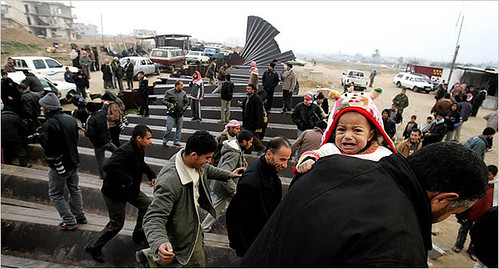
I mean, there is such a fine line between walls that are meant to keep people 'in' and walls that are meant to keep people 'out', if you think about it. Despite any stated intention, either way, a border wall will produce both consequences. For instance, while the US-Mexico border fence’s formal purpose is to keep unwanted immigrants out, its ultimate effect is to keep them inside Mexico. This is made even more paradoxical when you think about the border fence’s impact on those undocumented immigrants who are already within the U.S. and now probably feel trapped there because the risk of exiting the country and not being able to return has become too great.
So, again, the wall achieves both inside and outside conditions.
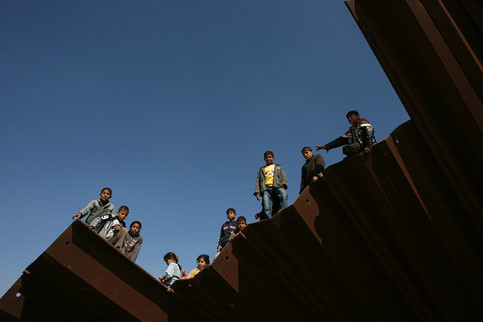
Same with the Gaza wall – while it’s been built to keep “terrorists” out it’s final goal is keeping Gazans within their own territory, where they are essentially starved of any sort of national livelihood. No wall has a singular dimensional effect, in fact it goes far beyond both sides who share it. The walls impact entire regions of migrant and labor flow, hardly beginning or ending at the site of the border itself.
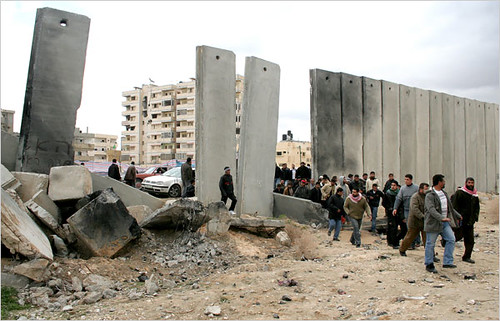

With this notion, it’s nearly impossible not to correlate the Gaza and Berlin walls this way -– if for the sheer visual potency of their images alone – and the legacy that walls have always continued to build through out history, that –- in this case -- forces one (at the very least) to consider the ironic connections between the Fall of Nazi Germany and the subsequent ignominious rise of Israel as a brutal occupier that must protect itself today behind miles and miles of resurrected barricade. Talk about a lineage of psycho-cultural impact. If the wounding the German psyche faces today as a result of its own heinous history is any indication, then the Israeli ego will have lots more to endure in generations to come. Or, as Daniel Levy asks, can Israelis ever recover from the self-inflicted damage of becoming a brutal occupier? I might add, can they ever recover from the damage that was done to them prior, because isn’t the current psychic identity of the Jewish state really just an extension of that wounding?


I make this connection not to pass judgment, but merely to suggest that a deeper language of political walls seems to be telling the story of global foreign policy, and what (if any) psycho-cultural morphology is revealing itself in the process. If the author of modern geopolitics were an architect then his narrative seems to unfold in the self-tortured pages of endlessly rising and crumbling walls. One can only wonder what the ripple effect of this latest un-walling in Palestine will bring to the future chapters of geopolitical space, and what new unborn references will eventually lead back to this one with similar wall-worn imagery.

Now that the world is embarked on such a border fence-building craze, I wonder, is it setting itself up for yet another day of wall reckoning with equally fervent domino effect where all the walls –- not just one this time –- will suddenly fall, wresting millions instead of thousands from de facto geographies of captivity? Will there be a spectacular moment of global un-walling? Is the nomadic fortress, that bombastic universal border wall I’ve described spanning multiple continents, destined for the greatest urban collapse ever known to man?

Today we have hundreds of thousands of Gazans to consider (just think about that number) breaching one of -- if not the most -- contentious political walls in history. It may not seem like a very significant number if you compare it to other disaster displacements around the world, but as Christian Lorentzen points out in his piece for Harpers, that’s roughly 13 percent of the territory’s entire population fleeing in a matter of moments, from the urban prison that is truly Gaza, surging past the brief and jagged openings of a nation not their own for dear life.
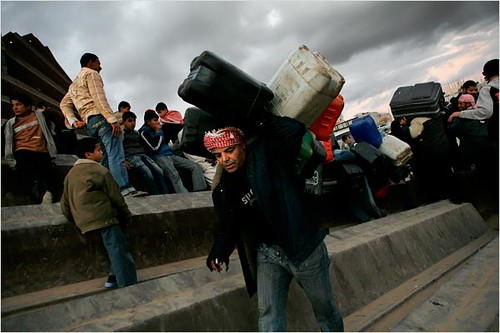
Having spent the last couple of days collecting tons of images of the whole thing it’s difficult actually to select just a few to post here (since I’d love to post them all!), and because over the last hundred hours or so the pictures themselves have woven a sort of equally twisted narrative of the whole event that is interesting to gage in the media’s own eyes. Yet, I can only imagine what it must feel like to be over there, in that sudden space of chaotic bliss and confusion—that epic fleeting pandemonium of momentary relief; the architectural pulse of facing a wall that has finally fallen.

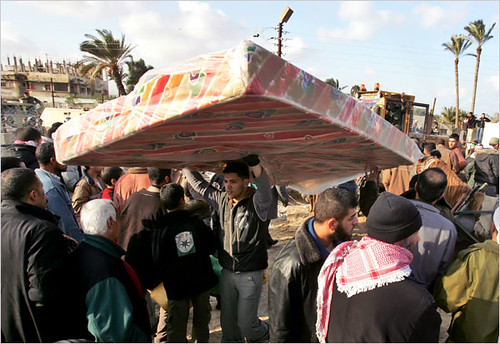
You've heard the stories now about men stocking up on gallons of gas with hopes of sustaining their families for months to come, people lining up in Egyptian towns just to get bread, light bulbs, batteries, rice – uh...bare essentials, people.
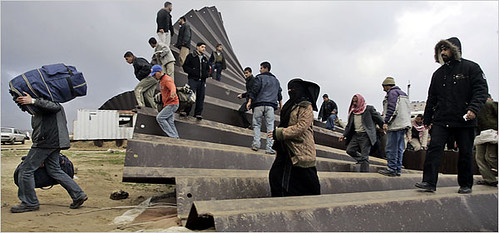

Yet, aside from the swarms of analysis surrounding the situation, I am (as you surely have guessed by now) totally obsessed with the images themselves.
Last Thursday night an audience member asked me if I thought ‘walls’ could be positive in any way; if ‘walls’ always had to connote negativity, or something to that effect anyway.
It’s a question that comes up a lot (not because I do a lot of presentations since we all know that I don’t), but here on Subtopia and in conversations whenever talking about borders and fences and alternatives to the “practical necessities of immigration enforcement” (whatever that may mean). And I usually say, you know, walls are the building blocks of space – they are the currency of architecture (to some extent) – and so, it’s not that I find walls at their very essence inherently wrong or inhumane, it’s more so in the context the walls are used, for precise political purposes, at what human expense, etc.

Anyway, that conversation resonates for me viewing these gnarled almost Richard Serra-like whirls of scrap metal that have been made out of the Gaza-Egypt border fence. I mean, I don’t want to attribute any sensationalistic over-symbolism here (of course, I can't really help myself either!), but there is something utterly stunning in the contortions of twisted steel that lay under the feet of thousands of women and children and families trampling over it like some kind of ghettoized rusted-red carpet; no longer towering over them as a symbol of tyranny and strangulation but becoming now the very structure that leads them to -- at least for the moment -- some temporary freedom, some temporary breathing room; a combustible space of border subversion and hope.

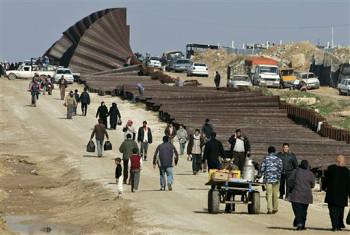
Parts of it looked like a great wilted helix, or a mythological border staircase unfolding over the territories, delivering this entire population from the insidious prison of their own homeland, while other parts were suddenly made a kind of post-catastrophic playground.
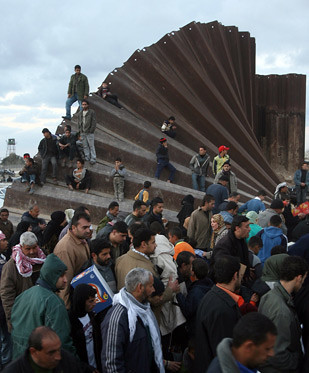
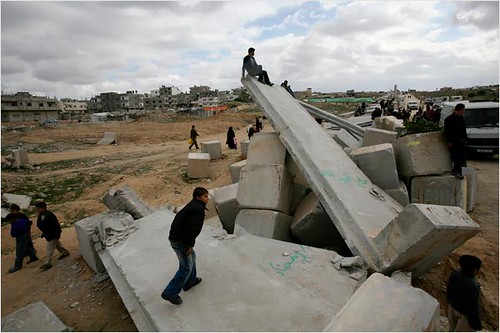
The image of the fence turning into this new pedestrial route that literally bridged them with some tiny epoch of freedom is irresistibly beautiful, rather than being this obstinate architecture of their demise. And how it came to so instantaneously, I guess I just find epically poetic, in a way. The symbolic power of converting the fence into a vessel, or a kind of demolished yet adapted freeway, even; an avenue of exodus navigated over obliterated steel – that’s some triumphant shit, right there, if you ask me.
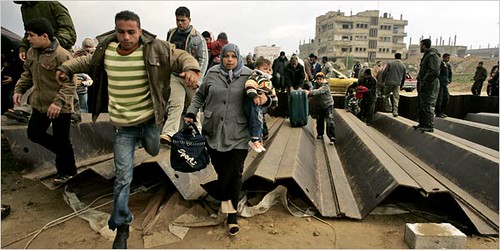
Be that as it may, I will try to say more in the future but this is obviously what you get when you apply the most extreme tactics of urban segregation through brutal military means, engineering perhaps one of the most pressurized conflict spaces this side of humanity has ever seen. The walls become the devices of their own demise, and a symbol of victory for the subjugated. On the frontlines of backlash, the walls become the burden of those who build them. At the very least, they expose the intolerable degrees of desperation that are raised by the isolationist politics of occupation.







16 Comments:
some triumphant shit indeed.
love the photo of the guy with the goats at the end.
but how is it you don't have the one of the guys pushing the horse up and over? that one got lots of coverage here in Bogota. loved it.
- Sara
ha!
yeah, like i said, i think i have a couple hundred shots.
got a cow being suspended mid air on pulleys over the fence. craziness!
there are so many i could include, i have the goats, in fact i have tons of pictures of gaza's goats headed over the wall.
even the animals get to roam free!
have you heard of the action activists did a few years ago at a camp where immigrants were being held in Australia where they cut down the fence and folks burst through? would be cool to see photos of that.
some good photos of us tearing down the fences at the School of the Americas over the years at opticalrealities.org
i've seen some aussie pics, and have some good ones of other fence actions in West Bank, but thanks for frwd'g me the school of america's action shots.
it could make a great project alone, documenting all of the fence actions. i know some websites already kinda do, but - to see an encyclopedia of de-fence (no pun intended) actions would be AWESOME.
DEFENCE.
The most interactive sculpture park Ive ever seen. Some of these shots are really beautiful.
just to let you know, the wall was blown in Gaza next to RAFAH, and Ramallah is in the west bank - about 300 miles away. although this thing has been smashed it is been closed up right now and it really does not put that much of a dent in the vicious and completely immoral bloackade and occupation of Palestinians by the Israeli army and the zionist state.
What strikes me is the contrast between the "big emotion" of bursting through the gap, next to the everyday stuff - shopping lists, suitcases, petrol cans, etc. Great photos by the way.
what i find interesting is that no one on the right (at least that I know of) has heralded this in terms of free-market capitalism breaking down borders and generally being irrepressible. After all, while people fleeing across borders in search of the means of survival is nothing new (I'm thinking of more traditional refugees), if you ignore the mangled wall of metal they are stepping over, these pictures are simply ones of people going shopping. The first geo-politcal triumph of consumers (opposed to citizens?)
It's interesting to juxtapose them next to pictures from "Black Friday" in the US or Boxing Day sales elsewhere. Consumers queing for hours to get what they came for, pushing and shoving, grabbing as much as you can carry while the gettings good.
jonathan
a chunk i omitted from my initial post was this:
"One thing that really creeps me out is how few people I’ve spoken with here in the U.S. seem to have very little clue of the significance of this explosion and the relevance it has for understanding Gaza as a kind of geopolitical pressure cooker, a hyper-volatile chamber of political and economic violence, that is regularly tweaked by both Hamas and the IDF for their own political gains. And I quickly get the tragic feeling, that the only terms I could possibly put this in for them to make any sort of sense or empathic connections is to compare this day to that ridiculous feeling of waiting the morning after Thanksgiving (after they have stuffed themselves to near death) for the Christmas shopping season to begin, in a long and hectic line of people that wraps around the building of some suburban Best Buy, milling about for hours for the gates to burst open and the security guards to dive out of the way just so millions of Americans can rush in and buy the latest DVD player in a mad sale shopping spree spending and consuming their way to heaven. These are the absurd historic moments in the American psyche where grandmas get trampled to death and cops beat the crap out of people for violently cutting in line to exploit the commercial frenzy. Even if you go as far as to try and tell them, that this is minimally what it is like every day for Palestinians not just trying to buy DVDs but food instead, they still don’t seem to get it; the gravity of what’s actually taking place over there, why the walls have come down – and that it’s not just another terrorist act in the Middle East. Craziness. "
delicious subversion
great post and nice pics! i trawled for ages, didnt find anything nearly as good
re: your ideas on the normative and conceptual issues regarding walls, check this article out. asks some very similar questions. maybe the nature of wall building has changed after all. permeable walls that can be transcended and transgressed can provide a medium of reciprocity, mutuality - they can help etch and negotiate identity. but mobility is key. whats changed is the nature and purpose of walls. check it out:
http://www.conflictincities.org/publication01.html
nasser
thanks, good article, and great resource!
There is no comparison between the walls. There is no "fine line". There is only the stark fact that some regimes try to keep people from running away from them and some do not. Those that do are illegitimate.
Many consider me to be a "virulent anti-Semite" but the reality is Israel is entirely within its rights not only to build walls to keep people out, but to shoot dead those who violate their territory.
Excellent pictures; but I do note that you have not mentioned the suicide bombers in Israel, appearing for the first time in a long while now that the wall is down. Interpretation is naturally your own business in your own blog, but is it really intellectually honest not to include this in a discourse that refers to Israel as a brutal occupier?
Silly question: You say "Ramallah", but do you really mean Ralah? Ramallah looks to my untrained eye to be dead in the middle of the West Bank, and if this is on the border with Egypt and these are residents of Gaza that makes that geography unlikely.
for whatever reason -- strange -- i wrote Ramallah oviously meaning Rafah. and no dan lyke, it's no a silly question - but, i didn't mean 'Ralah' either.
strange mistake but thanks to all for catching it.
real quick: there are tons of other issues i could have and would have liked to addressed in this post (namely the smugglers and what the wall breach has done to them), but tons of other issues, too. i chose not to b/c i wanted to appreciate the images and the moment itself the Gazans must have been feeling.
To say I should have brought up the recent suicide bombing and call me intellectually dishonest for not (this post was written prior to the recent event, by the way, in case you hadn't noticed!) is ludicrous. this post isn't meant to touch every aspect of the conflict as glimpsed through the prism of the fallen wall.
please keep that in mind.
You know whats funny?..
Its funny that even after the jews prove to the world how much they have contributed to the advancement of mankind, people still believe to eagerly type something negative about the jews on the media.. Why? No no REALLY why?? Im not saying that they are perfect and error-less. everybody has their own defects but seriously, if you really look at the big picture, the world and everything in it, you would most definitely see that it is quite foolish to speak in such ways about the jews.. If anybody needs some more info about if the jews werent here, then I can tell them exactly what kind of world this would have been without them.. Oh by the way, did you know that the little camera on your cell phone was invented in Israel by the jews.. Funny isnt it :)
Post a Comment
<< Home